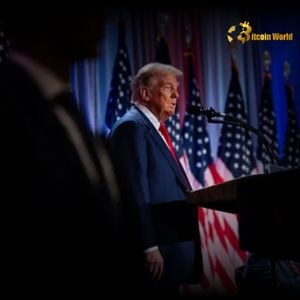Trump Tariffs: Trump Vows Fierce Trade Court Battle Victory
7 min read
BitcoinWorld Trump Tariffs: Trump Vows Fierce Trade Court Battle Victory In the ever-evolving landscape of global economics and political maneuvering, news broke via Walter Bloomberg on X that former U.S. President Donald Trump has declared his firm intent to win the court battle concerning tariffs. This declaration isn’t just a statement; it signals a renewed focus on a contentious area of US trade policy that has significant implications beyond borders, potentially even rippling into financial markets watched closely by cryptocurrency enthusiasts. Understanding the Trump Tariffs and the Trade Court Battle When we talk about Trump tariffs , we’re referring primarily to the duties imposed during his presidency under Section 232 of the Trade Expansion Act of 1962 (citing national security concerns, mainly on steel and aluminum imports) and Section 301 of the Trade Act of 1974 (in response to unfair trade practices, notably targeting China). These tariffs sparked significant opposition, leading to legal challenges in various courts, including the U.S. Court of International Trade and the U.S. Court of Appeals for the Federal Circuit. The trade court battle involves complex legal arguments. Opponents argue that these tariffs were unlawfully imposed, exceeding presidential authority or violating procedural requirements. The government, under Trump, defended them as necessary measures to protect domestic industries and national security. The ongoing legal disputes center on the scope of presidential power under these trade statutes and whether the executive branch followed the correct legal procedures. Here’s a simplified look at the key legal fronts: Section 232 Cases: Challenges against tariffs on steel and aluminum, often arguing they weren’t truly based on national security or that the process was flawed. Section 301 Cases (China Tariffs): Lawsuits contending these tariffs were an unauthorized escalation of trade disputes beyond the scope of Section 301’s original intent or that the process lacked proper public notice and comment. Constitutional Challenges: Some cases touch upon the separation of powers, questioning whether Congress improperly delegated too much tariff authority to the President. Why is Winning the Court Battle So Crucial for Trump’s Political Strategy? Donald Trump’s political identity is heavily intertwined with his ‘America First’ economic agenda, where using tariffs as a tool for negotiation and protection was a centerpiece. Vowing to win the court battle isn’t just about the legal outcome; it’s a critical part of his ongoing political strategy . Securing legal victories would: Validate Past Actions: A court win would retroactively legitimize a core policy of his presidency, allowing him to claim vindication against critics who argued his tariffs were illegal or poorly implemented. Empower Future Policy: Winning sets potential precedents that could provide a stronger legal basis for implementing similar or expanded tariffs if he were to return to office. Reinforce Political Narrative: It aligns with his message of being a strong leader willing to fight for American workers and industries against foreign competition and perceived unfair practices. It’s a way to demonstrate resolve and commitment to his base. Maintain Leverage: While the specific cases might pertain to past actions, the legal principles at stake could influence the executive branch’s power regarding trade measures, impacting future negotiation leverage. This isn’t merely a legalistic stance; it’s a strategic move aimed at shaping public perception and solidifying his policy credentials ahead of potential future political endeavors. Challenges and Hurdles in the Trade Court Battle Despite Trump’s confident declaration, winning these legal challenges is far from guaranteed. The trade court battle presents significant challenges and legal hurdles: Legal Arguments Against Tariffs: The core of the opposition’s case often rests on challenging the statutory basis or the implementation process. For Section 232 tariffs, opponents question whether the national security justification was genuine or merely a pretext for economic protectionism, which is typically outside the scope of the act. For Section 301 tariffs, arguments often revolve around whether the actions taken directly addressed the ‘unfair practices’ identified and whether the process adhered to administrative law requirements, such as providing adequate opportunity for public input. Judicial Scrutiny: While courts often grant deference to the executive branch on matters of foreign policy and national security, this deference is not unlimited. Courts will examine whether the executive branch acted within the authority granted by Congress and followed the procedures mandated by law. Judges are tasked with interpreting complex trade statutes, and different panels of judges can arrive at different conclusions, leading to appeals and prolonged litigation. Precedent and Interpretation: Trade law is a specialized and often complex area. The outcome of these cases can depend heavily on how judges interpret specific phrases within decades-old statutes and how they apply existing legal precedents regarding executive power and administrative procedure. Novel arguments or interpretations could sway decisions. Winning requires successfully defending the administration’s interpretation of its authority and demonstrating that all legal procedures were correctly followed, a task made difficult by the complex and often controversial nature of the tariff decisions themselves. What is the Potential Economic Impact of the Tariff Court Outcomes? The outcome of the trade court battle carries potential implications for the economy. While specific impacts are debated among economists, here are some potential areas of influence: Certainty vs. Uncertainty: A definitive ruling, whether upholding or striking down the tariffs, could reduce uncertainty for businesses. If tariffs are upheld, companies that adjusted supply chains or absorbed costs might see the status quo confirmed. If struck down, it could lead to refunds of duties paid (potentially billions of dollars) and a reversal of trade flows, requiring new adjustments. Industry Competitiveness: Industries that benefited from tariff protection (like domestic steel and aluminum producers) could face renewed foreign competition if tariffs are removed. Industries that were harmed by retaliatory tariffs on U.S. exports could see markets reopen. Consumer Costs and Inflation: Tariffs are taxes on imports, often leading to higher costs for consumers or businesses that use imported goods. Removing tariffs could potentially lower costs, while upholding them maintains this upward pressure on prices, contributing to inflationary concerns. Global Trade Relations: The legal outcome could influence the U.S.’s standing in global trade negotiations and its relationship with key trading partners. A ruling that limits presidential authority might necessitate a different approach to trade disputes in the future. For those watching the broader markets, including cryptocurrency, significant shifts in trade policy or large-scale refunds/impositions of duties could add to macroeconomic volatility, which sometimes correlates with movements in digital asset prices, although this link is indirect and complex. Exploring the Broader Implications for US Trade Policy The legal fight over Trump tariffs is more than just about past duties; it’s about the future of US trade policy . The court’s decisions will help define the boundaries of executive power in using tools like Section 232 and Section 301. Potential Outcomes and Their Effects: Tariffs Upheld: This would affirm broad presidential authority under these statutes, potentially making it easier for future administrations (including a potential second Trump term) to implement similar unilateral trade measures. Tariffs Struck Down: This would constrain presidential power, potentially forcing future administrations to rely more on congressional action or international trade bodies like the WTO (despite its current challenges) to address trade grievances. Mixed Rulings: Courts might uphold some tariffs while striking down others based on the specific legal arguments, leading to a more nuanced definition of executive trade authority. The outcome will be closely watched by trade partners, international organizations, and businesses worldwide, as it will signal how the U.S. government can and will likely use its trade levers in the years to come. This foundational aspect of economic interaction is a key factor in global stability, which in turn, can influence investor sentiment across all asset classes. What Actionable Insights Can We Glean? While this trade court battle might seem distant from the day-to-day world of cryptocurrency, understanding its potential ramifications offers valuable insights: Monitor Macro Trends: Pay attention to how major economic policy disputes like this progress. Outcomes could influence inflation, supply chain stability, and overall market sentiment – factors that can indirectly affect the crypto market. Understand Political Influence: Recognize that political strategies and legal battles over economic policy are interconnected. Trump’s vow highlights how trade remains a potent political tool, and its use can create volatility or shift economic landscapes. Diversification Awareness: The uncertainty generated by such high-stakes legal and political battles underscores the importance of understanding diverse market drivers and potentially considering diversification strategies, whether within crypto or across different asset classes (this is not financial advice, merely an observation on market dynamics). Stay Informed: Follow reputable news sources covering trade law and economic policy. Understanding the potential legal precedents being set can provide context for future government actions impacting the economy. The declaration by Trump to win the court battle is a reminder that fundamental economic policies are still being shaped and challenged through legal and political means, with consequences that can extend into various facets of the financial world. Conclusion: The Stakes of the Tariff Court Battle Donald Trump’s pledge to secure victory in the ongoing legal challenges against his administration’s tariffs underscores the significant stakes involved. This isn’t just about past policies or collecting duties; it’s a pivotal trade court battle that will help define the future scope of presidential authority in setting US trade policy . The legal complexities, combined with the potential for substantial economic impact on industries, consumers, and global trade relations, make this a closely watched issue. For Trump, winning is also a crucial element of his ongoing political strategy , aiming to validate his ‘America First’ approach and position himself for future influence. While the direct link to cryptocurrency might seem tenuous, the broader implications for economic stability, market volatility, and the global political landscape are factors that informed participants in any market, including digital assets, should consider. The outcome of these legal battles will contribute to the complex web of forces shaping the economic environment for years to come. To learn more about the latest economic policy trends, explore our articles on key developments shaping global markets and institutional adoption. This post Trump Tariffs: Trump Vows Fierce Trade Court Battle Victory first appeared on BitcoinWorld and is written by Editorial Team

Source: Bitcoin World



